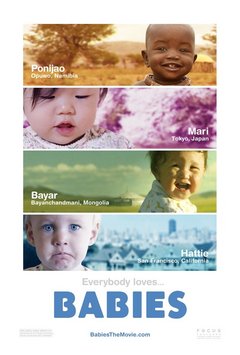
BEBES (BABIES)
France, 2010, 79 minutes. Colour.
What the title says is what we get. And, even the most curmudgeonly codger who finds children, let alone, babies, one of the banes of life, would probably be charmed.
This is a brief documentary, strong on images, with no voiceover commentary and, indeed, very few words heard except bits in passing from some of the parents. We are invited to look, to respond emotionally, to think, and to appreciate the wonder of life that is conception, pregnancy, giving birth and loving and rearing children.
There are four families we are invited to join: in Namibia, a tribal way of life in a desert village; in Tokyo, a quite affluent, technological way of life; in Mongolia, a family community out in the countryside (with large home tents like those movie buffs will remember from The Story of the Weeping Camel and The Cave of the Yellow Dog); in San Francisco, a home with the comforts that the average middle class can take for granted.
After we are introduced, especially to the four mothers and their giving birth, sequences are intercut throughout the film, following the timeline from the birth of the children to the period after their first birthday – and a nice postscript during the final credits of how they look after the film has been edited and ready for release.
Of course, it is fascinating to watch the newly born children immediately after their birth and how they gradually come to life in the succeeding weeks; then the beginnings of movement from crawl to standing to walking; then the gurgles and sounds and words. Children are basically the same in their development the world over.
However, we are shown more than sufficient footage to appreciate the mothers and their care, again according to local customs and ways and in the context of other children. Interestingly, we see no father in Namibia but rather the mother and her bonds with the other mothers, sitting in the dust, talking and sharing, and the children playing and learning to relate. We don’t see a father to all intents and purposes in Mongolia. It is the mother and the other children who are the key personal presence for the baby. After a while, the father is seen in San Francisco, especially his playing with his daughter and the outings, but the key presence is the mother and, again, with other mothers. From the outset in Tokyo, we see both mother and father, very young, with their daughter (whom we notice at ease on chairs near computers and other machines).
Everybody will bring their own agenda to Babies and that will determine the kind of response we make, how much interest, how much empathy, how much curiosity – and how much satisfaction that this is how the human race propagates itself and continues.
1. The impact of the film? Audience response to babies?
2. Different audience responses to babies? Mothers? Fathers? Grandparents? Those who have not had children? The babies in this story charming all audiences?
3. The documentary, the lack of commentary? Letting the images make an impact? Suggestions of dialogue scarcely heard? The effect of this kind of immersion in the stories?
4. The location photography, Namibia, Mongolia, Japan, the United States? The variety? The feel for each place? The visual impact? The musical score?
5. The intercutting of the stories and the effect?
6. The range of the time span: from giving birth, to the baby’s first birthday, the aftermath?
7. The Namibian story: the mothers, in the desert, sitting on the ground, the community of mothers, the absence of the men? The children and their playing, squabbles? Birth in this condition? Tending the baby, breastfeeding? The babies and their development, with the other children? Looked after by the women? Beginning to stand, beginning to speak?
8. The Mongolian story: the outskirts of the towns, the countryside, the desert? The huge tents as homes? The interiors? The family, the mother and the giving birth in the hospital, her return home? The other children? Welcoming the baby or not? Tending the baby? The presence of the men – but more absent? The children playing with each other, the child learning to crawl, stand, talk? The birthday?
9. Japan: the photography of Tokyo, the city atmosphere, the technology, even in the homes, the young parents? The father and his continued presence? The baby, the tender care? Taking her out, the walks in the park? Crawling, standing, speaking? The care from the parents, in the context of family and the city?
10. The United States: the photography of San Francisco, a middle-class and more affluent world? The giving birth, the hospital? The nursing care? The mother, bringing the child home, the mod-cons for the child? The growing presence of the father? The outings? The mother and her going to groups, their discussions? The baby crawling, standing, speaking? The preparations for the birthday and the celebration?
11. The cumulative effect of seeing these four children? Admiration for mothers? The delight of the children and their growth? The reactions of other members of the family, present and absent fathers, other children?
12. The film as a celebration of life?